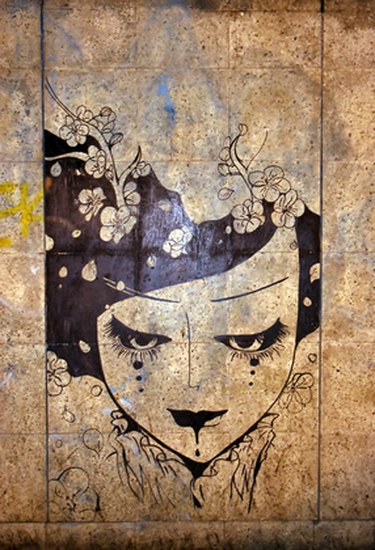
Silk painting is a form of art that originated in India and Eastern Asia and has stood the test of time. Silk paintings date back to 200 CE in India, where wax resist and Batik techniques are traced. As the tradition spread through Eastern Asia, Japan honed methods of silk cultivation and adapted its own style of Silk Painting as art. Although content, influences and techniques have been modified over time, the practice of laying paint or ink over silken material has remained constant.
Timeline
Video of the Day
The earliest development of silk and silk painting took place in India around 2nd century CE, and it was shortly after that similar techniques were developed in China. Japanese art was heavily influenced by Chinese culture. The earliest complex art from Japan came between the 7th and 8th centuries. In the 9th century CE Japan became more culturally independent with its art, along with the spread of Buddhism. This is also around the time they discovered methods of silk production and silk painting. Early Japanese silk paintings were done with black ink or paint, and were generally monochromatic. Entering the 14th century Japanese artists began using a range of pigment, adding color to paintings. Between the 16th and 18th centuries silk painting began to spread from its origins in Eastern Asia across the continent and eventually world-wide as intercontinental trade began to take place. In the 18th century, with the rise of the industrial revolution, silk became a readily accessible canvas and was popularized with European countries such as France. Today the art of silk painting continues to flourish and Japan ranks top as the cultural originator of the tradition, says silk-painting expert Gill Kitchen.
Video of the Day
Origin of Silk Painting
The cultivation of silk has taken place for more than 3,500 years, originating in India and China. Silk is made from the natural material produced by silkworms. Although Chinese people originated the practice of silk harvesting in Eastern Asia, the Japanese got hold of silkworm eggs and began the production of silk. It was through Japan that silk production became widespread. Both Japan and China began using silk canvases for artistic means at around the same time, during the ninth century CE.
Influences
The largest influence for Japanese silk painting from its origin was Buddhism. It was with Buddhism that Japan originated its cultural and artistic identity. Another influence of Japanese art, and a common theme among early silk paintings, were historical events or heroes. Another common theme in Japanese art is the idea of "the insignificance of man," which is the reason many Japanese paintings depict nature. Some natural elements common in Japanese silk paintings are birds, flowers, wildlife, mountains, trees and bamboo.
Practices
Until the 14th century, the Japanese used a brush rather than a pen for calligraphy and writing, to which their concise and perfected skill in painting can be attributed. Japanese artists use fine strokes and minute details to compose intricate paintings. Another common practice in early Japanese art is the incorporation of written poetry into art to help convey the message of the painting. Japanese Buddhists were also known to meditate before and while they painted, attributing spirituality to their art.
Techniques
The Serti technique is a way of using water-resistant barriers to outline designs so the colors do not intermingle. The Gutta resist technique uses water-based resins to create designs. This technique generates a rubbery texture and is generally used for hanging art rather than clothing. Similar to tie-dyeing, the Shibori painting technique uses fast-drying dyes to create colorful designs. This is a common technique for silk clothing.